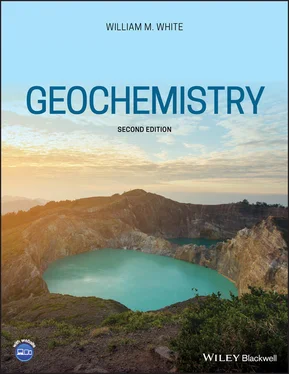In Chapter 11, we turn our attention to solid Earth, its composition and its differentiation into layers: crust, mantle, and core. One question we would like to answer is what is the composition of the Earth? Since the mantle is the largest and most massive of these layers, we begin there. Because we only rarely find mantle material at the surface, geophysical observations such as seismic waves, gravity, and moment of inertia provide particularly critical constraints on the nature of the mantle. The composition of blocks of mantle occasionally thrust to the surface, small pieces of it carried to the surface in volcanic eruptions, and the composition of magma produced by melting of the mantle are also critical in constraining its nature. Finally, chondritic meteorites provide the inventory of materials available to form the Earth; while the Earth certainly differs in its composition from chondrites, we need to relate terrestrial composition to that of chondrites in a way consistent with thermodynamics and what we know of the behavior of the elements. We'll find that most modern estimates converge on an estimate of terrestrial composition within a few percent for the most abundant elements. For trace elements, estimates diverge by 25% or so, but that is nevertheless remarkable, considering how heterogeneous the Earth is.
The heterogeneous nature of the mantle comes into full focus when we examine the trace element and isotopic composition of basalts. Basalts are our most abundant mantle sample, but as partial melts they are not compositionally representative except for isotope ratios. The understanding of trace element behavior in partial melting and fractional crystallization we gain in Chapter 7nevertheless allows us to constrain mantle trace element compositions. What we find from combining trace elements and isotope ratios is that the mantle consists of identifiable chemical reservoirs whose evolution we can partly reconstruct. Mid-ocean ridge basalts, easily the most voluminous on the planet, come from a shallow reservoir from which melt has previously been extracted to form the crust. Oceanic island and other basalts produced by melting of mantle plumes rising from the deep mantle clearly derive from different reservoirs. Although these too shows evidence of previous melt extraction, they have been reenriched in the elements lost. Furthermore, stable isotope ratios in these basalts demonstrate conclusively that they contain material once at the surface of the Earth. This is truly remarkable: the surface and deep Earth are connected by a grand geochemical cycle.
The core, as we noted earlier, consists of iron-nickel alloy. You might ask how can we be confident about the composition of something we have never sampled and have no prospect of ever sampling? The answer is again the geophysical constraints, which tell us that the core is very dense, and the composition of chondrites, which tell us that the only elements of sufficient abundance and density to form the core are iron and nickel. That conclusion is reinforced by iron meteorites, most of which are cores of asteroids. There is a problem, however; namely, that any combination of iron and nickel will be denser than the Earth's core at relevant temperatures and pressures. These elements must thus be diluted with perhaps some 5% or so of one or more lighter elements. The meteorite inventory of what was available and the isotopic composition of some of the candidate light elements, such as silicon, helps us narrow the possibilities, but we do not yet have a firm answer. Experiments showing how elements partition between silicate and iron liquids together with thermodynamics places important constraints on what is possible. Comparing the composition of the mantle with that of chondritic meteorites show that the mantle is highly depleted in elements, including the most valuable metals such as platinum and gold, that we expect to partition into iron liquid and since this partitioning is temperature and pressure dependent, we can begin to develop scenarios on how the core formed.
Then we turned to the crust, first the oceanic crust, then to the continental crust. The first question is its composition, an easier one to answer than the composition of mantle and core. It is not an easy task, however, given how heterogeneous the crust is and while the surface is easily sampled, the lower crust is not. Nevertheless, we continue to build on the work of Clark and Goldschmidt and refine estimates of crustal composition. Then we turn our attention to how the crust formed. We can certainly establish that the continental crust has formed through partial melting of the mantle, but in what tectonic environment under what circumstances, and when? Did it form early in Earth's history, steadily through time or in pulses, or perhaps only recently? And how permanent is it? We know a lot, but we're still struggling to completely answer these questions.
Life is, of course, ubiquitous at the surface of the Earth and has modified the planet in remarkable ways: life is a geologic force. Organisms produce a vast array of chemicals that find their way into the physical environment. As we noted, modern geochemistry differs from what Schönbein envisioned in that it encompasses organic as well as inorganic matter, and these organic substances are ubiquitous at the surface of the Earth. This is the subject to which we turn in Chapter 12. After briefly exploring the nature and structure of organic compounds and the role they play in life, we'll survey their presence in soils and natural waters. Once outside a cell, organic substances are subject to attack by microbes and begin to degrade almost immediately. Yet some can survive on millennial time scales and longer. An emerging paradigm emphasizes the importance of adsorption of mineral surfaces in resisting degradation. The ability of dissolved organic molecules to adsorb complex inorganic substances is important: it retains nutrients in soil and maintains otherwise insoluble metals in solution. Some of these long surviving molecules, or at least their hydrocarbon skeletons, can be associated with specific biomolecules. Some of these biomarkers , or chemical fossils, are restricted to specific groups of organisms and can thus help us reconstruct past environments and biological evolution. Others have proved useful in reconstructing past atmospheric CO 2levels and paleotemperatures.
Organic substances are an important part of the carbon cycle. Photosynthesis and subsequent sequestration of organic matter in sedimentary rocks transformed the Earth's initial CO 2-rich atmosphere to one containing free oxygen, which first occurred 2.3 billion years ago in the Great Oxidation Event . For the next billion and a half years, some atmospheric oxygen was present, but not enough to support metazoans (animals). Then around 600 million years ago, atmospheric oxygen levels began to rise again and just at this time the first animals appear in the fossil record. But as oxygen was produced, atmospheric CO 2was drawn down. As a greenhouse gas, CO 2plays a critically important role governing climate and the times oxygen rose in the atmosphere were accompanied by glaciations in the Proterozoic and Paleozoic.
This was not the cause of the Pleistocene glaciations, however. Stable isotope studies demonstrated that glacial-interglacial cycles correlated with small changes in the Earth's orbit and rotation (the Milankovitch variations). These were the pacemaker of the Pleistocene glacial cycles, but it was shuffling of CO 2between the atmosphere and oceans that actually caused the climate swings.
Burial of organic carbon in sediments has also produced the coal and petroleum that have provided the energy to power the global economy since the Industrial Revolution. We'll examine the processes that transform this buried organic matter into these energy resources. But in burning fossil fuels we are increasing atmospheric CO 2, which, not surprisingly, is warming the planet and initiating a host of other climate changes.
Читать дальше












